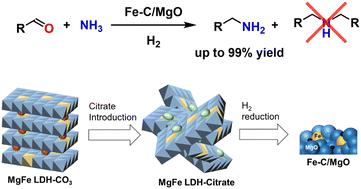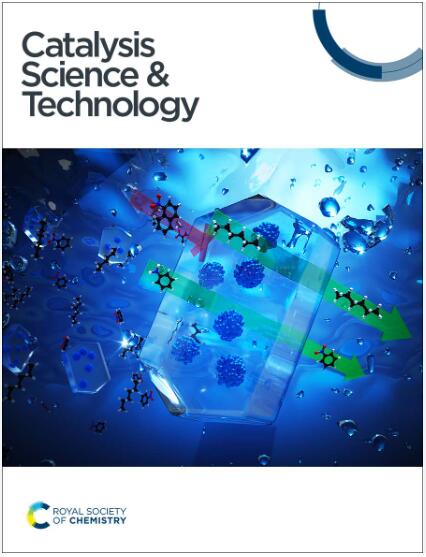Supported Fe catalysts prepared through layered double hydroxides for primary amine synthesis by reductive amination of carbonyl compounds†
IF 4.4
3区 化学
Q2 CHEMISTRY, PHYSICAL
引用次数: 0
Abstract
Reductive amination of carbonyl compounds with ammonia using H2 as a reductant is a highly powerful method for synthesizing primary amines. To enhance sustainability, however, there is a need to develop heterogeneous catalysts based on iron, which is abundant and inexpensive. Previously reported Fe-based heterogeneous catalysts require a high reaction temperature and high H2 pressure, probably due to the agglomeration of Fe particles during the reduction of iron oxide precursors. We discovered that layered double hydroxides (LDHs) were suitable precursors for preparing supported Fe catalysts. Reduction of Mg- and Fe-based LDHs (MgFe-LDHs) after introducing citrate furnished MgO-supported Fe catalysts (Fe–C/MgO) with small Fe and MgO particles. Fe–C/MgO worked as a reusable and stable heterogeneous catalyst for reductive amination at a low temperature and low H2 pressure; the benzylamine yield from benzaldehyde reached 99% even at 80 °C under 1.5 MPa H2 pressure. Introducing citrate to the LDHs not only suppressed the crystal growth of Fe and MgO particles but also facilitated the reduction of iron oxides to metallic Fe. This work demonstrates a promising method for the preparation of supported Fe catalysts with small Fe particles.


通过层状双氢氧化物制备的支撑铁催化剂,用于通过羰基化合物的还原胺化合成伯胺
以 H2 为还原剂,用氨对羰基化合物进行还原胺化反应是合成伯胺的一种高效方法。然而,为了提高可持续性,有必要开发基于铁的异相催化剂,因为铁的资源丰富且价格低廉。之前报道的铁基异相催化剂需要较高的反应温度和较高的 H2 压力,这可能是由于氧化铁前驱体还原过程中铁颗粒团聚所致。我们发现层状双氢氧化物(LDHs)是制备支撑铁催化剂的合适前驱体。在引入柠檬酸盐后还原镁基和铁基 LDHs(MgFe-LDHs),得到了具有小的铁和氧化镁颗粒的氧化镁支撑铁催化剂(Fe-C/MgO)。Fe-C/MgO 是一种可重复使用的稳定异相催化剂,可在低温和低氢气压力下进行还原胺化反应;即使在 80 °C 和 1.5 兆帕氢气压力下,苯甲醛的苄胺产率也能达到 99%。在 LDHs 中加入柠檬酸盐不仅能抑制铁和氧化镁颗粒的晶体生长,还能促进铁氧化物还原成金属铁。这项工作展示了一种制备具有小铁颗粒的支撑铁催化剂的可行方法。
本文章由计算机程序翻译,如有差异,请以英文原文为准。
求助全文
约1分钟内获得全文
求助全文
来源期刊

Catalysis Science & Technology
CHEMISTRY, PHYSICAL-
CiteScore
8.70
自引率
6.00%
发文量
587
审稿时长
1.5 months
期刊介绍:
A multidisciplinary journal focusing on cutting edge research across all fundamental science and technological aspects of catalysis.
Editor-in-chief: Bert Weckhuysen
Impact factor: 5.0
Time to first decision (peer reviewed only): 31 days
 求助内容:
求助内容: 应助结果提醒方式:
应助结果提醒方式:


